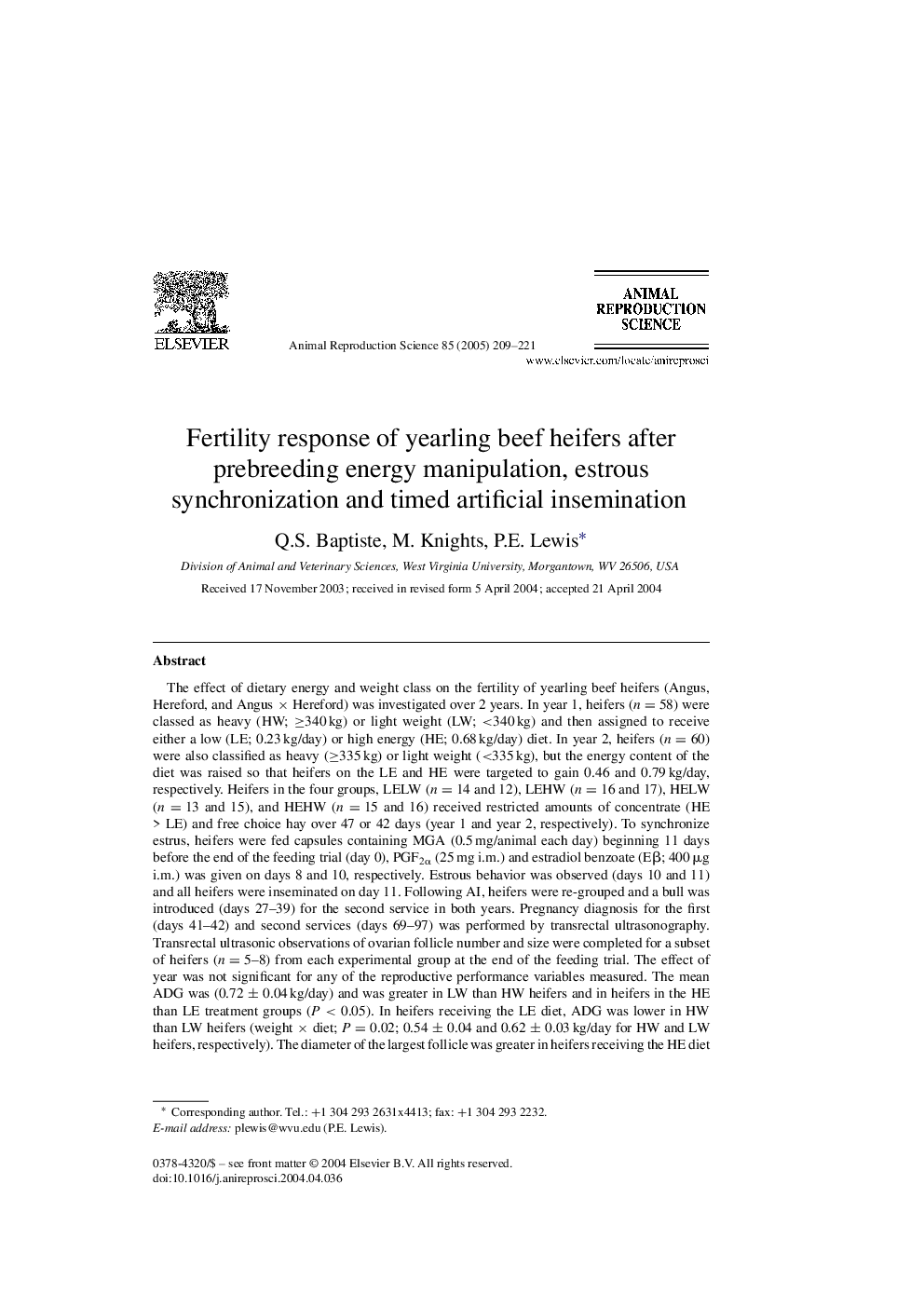| کد مقاله | کد نشریه | سال انتشار | مقاله انگلیسی | نسخه تمام متن |
|---|---|---|---|---|
| 9900363 | 1544843 | 2005 | 13 صفحه PDF | دانلود رایگان |
عنوان انگلیسی مقاله ISI
Fertility response of yearling beef heifers after prebreeding energy manipulation, estrous synchronization and timed artificial insemination
دانلود مقاله + سفارش ترجمه
دانلود مقاله ISI انگلیسی
رایگان برای ایرانیان
موضوعات مرتبط
علوم زیستی و بیوفناوری
علوم کشاورزی و بیولوژیک
علوم دامی و جانورشناسی
پیش نمایش صفحه اول مقاله

چکیده انگلیسی
The effect of dietary energy and weight class on the fertility of yearling beef heifers (Angus, Hereford, and Angus à Hereford) was investigated over 2 years. In year 1, heifers (n = 58) were classed as heavy (HW; â¥340 kg) or light weight (LW; <340 kg) and then assigned to receive either a low (LE; 0.23 kg/day) or high energy (HE; 0.68 kg/day) diet. In year 2, heifers (n = 60) were also classified as heavy (â¥335 kg) or light weight (<335 kg), but the energy content of the diet was raised so that heifers on the LE and HE were targeted to gain 0.46 and 0.79 kg/day, respectively. Heifers in the four groups, LELW (n = 14 and 12), LEHW (n = 16 and 17), HELW (n = 13 and 15), and HEHW (n = 15 and 16) received restricted amounts of concentrate (HE > LE) and free choice hay over 47 or 42 days (year 1 and year 2, respectively). To synchronize estrus, heifers were fed capsules containing MGA (0.5 mg/animal each day) beginning 11 days before the end of the feeding trial (day 0), PGF2α (25 mg i.m.) and estradiol benzoate (Eβ; 400 μg i.m.) was given on days 8 and 10, respectively. Estrous behavior was observed (days 10 and 11) and all heifers were inseminated on day 11. Following AI, heifers were re-grouped and a bull was introduced (days 27-39) for the second service in both years. Pregnancy diagnosis for the first (days 41-42) and second services (days 69-97) was performed by transrectal ultrasonography. Transrectal ultrasonic observations of ovarian follicle number and size were completed for a subset of heifers (n = 5-8) from each experimental group at the end of the feeding trial. The effect of year was not significant for any of the reproductive performance variables measured. The mean ADG was (0.72 ± 0.04 kg/day) and was greater in LW than HW heifers and in heifers in the HE than LE treatment groups (P < 0.05). In heifers receiving the LE diet, ADG was lower in HW than LW heifers (weight à diet; P = 0.02; 0.54 ± 0.04 and 0.62 ± 0.03 kg/day for HW and LW heifers, respectively). The diameter of the largest follicle was greater in heifers receiving the HE diet (P < 0.05; 11.3 ± 0.4 mm) than those on the LE diet (10.3 ± 0.3), and in LW (P < 0.05) compared to HW heifers. The HE diet increased the size of the largest follicle in LW but not HW heifers (diet à weight, P < 0.05). The percentage of pubertal heifers at the end of the feeding period (59.3%), estrous response (56.4%), conception rate (47.7%), ovulation rate (88.9%), and first service pregnancy rate (36.2%) were not significantly affected by initial weight or diet. There was a tendency for first service pregnancy rates to be greater in LW than HW heifers consuming the LE diet (diet à weight, P < 0.1; 54.2 ± 15 and 30.3 ± 10% for LELW and LEHW heifers, respectively). Pregnancy rate after two services was greater (P = 0.01) in LW (82 ± 10%) than in HW (64.5 ± 10%). The LE diet achieved moderate rates of gain and allowed high level of reproductive performance in LW but not HW heifers.
ناشر
Database: Elsevier - ScienceDirect (ساینس دایرکت)
Journal: Animal Reproduction Science - Volume 85, Issues 3â4, February 2005, Pages 209-221
Journal: Animal Reproduction Science - Volume 85, Issues 3â4, February 2005, Pages 209-221
نویسندگان
Q.S. Baptiste, M. Knights, P.E. Lewis,